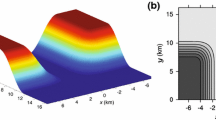Abstract
The characteristics of dynamics and thermodynamics of the atmospheric boundary layer in a part of the Colorado River Valley, centered around Lake Mohave, have been investigated by analysis of measurements conducted during a field program in late spring and early summer of 1986 and a series of numerical simulations by a three-dimensional second-moment turbulence-closure model. The model was validated against measurements described in a companion article (Engeret al., 1993). According to airsonde measurements performed on eight nights, the depth of the surface inversion was around 200 m with an average temperature gradient of about 30 K km−1. Analysis of acoustic sounder data collected during one month revealed significant diurnal variations ofU andV wind-speed components related to slope and valley flows, respectively. Some of the dynamics properties have been explained by the simulation results. It has been shown that the appearance of supergeostrophic southerly valley flow is associated with the westerly component of the geostrophic flow. Since a westerly component of the geostrophic wind is quite common for this area in summer, this effect also explains the frequently observed southerly valley flow in summer. Elevated minima of the measured wind speed around valley ridges appear to be related to the interaction of conservation of momentum in theX andY directions. The critical direction of the geostrophic wind relevant for reversal of up-valley flow to down-valley flow has also been studied. The critical direction is about 300° for one of the measurement sites and, depending on the angle between valley axis and south-north direction, the critical direction is expected to vary by about 15–20°. The scale analysis of the simulated equations of motion and turbulence kinetic energy emphasizes the strong impact of meandering of the flow due to actual topographic complexity.
Similar content being viewed by others
References
Andrén, A.: 1990, ‘Evaluation of a Turbulence Closure Scheme Suitable for Air-Pollution Applications’,J. Appl. Meteorol. 29, 224–239.
Blumen, W. (ed.): 1990,Atmospheric Processes over Complex Terrain, Meteorological Monographs, Vol. 23, Amer. Meteorol. Society, 45 Beacon Street, Boston, MA 02108, USA.
Clements, W. E., Archuleta, J. A. and Hoard, D. E.: 1989, ‘Mean Structure of the Nocturnal Drainage Flow in a Deep Valley’,J. Appl. Meteorol. 28, 457–462.
Deardorff, J. W.: 1978, ‘Efficient Prediction of Ground Surface Temperature and Moisture, with Inclusion of a Layer of Vegetation’,J. Geophys. Res. 83 (C4), 1889–1903.
Doran, J. C.: 1991, ‘The Effect of Ambient Winds on Valley Drainage Winds’,Boundary-Layer Meteorol. 55, 177–189.
Doran, J. C. and Horst, T. W.: 1983, ‘Observations and Models of Simple Nocturnal Flows’,J. Atmos. Sci. 40, 707–717.
Egan, B. A. and Schiermeier, F. A.: 1986, ‘Dispersion in Complex Terrain: a Summary of the AMS Workshop Held in Keystone, Colorado, 17–20 May 1983’,Bull. Am. Meteorol. Soc. 67, 1240–1247.
Enger, L. and Koračin, D.: 1992, ‘Simulation of Dispersion of Atmospheric Pollutants in Complex Terrain’, Paper 92-102.3, Air and Waste Management Association,85th Annual Meeting and Exhibition, Kansas City, Missouri, June 21–26, 1992.
Enger, L., Koračin, D. and Yang, X.: 1993, ‘A Numerical Study of the Boundary-Layer Dynamics in a Mount Valley. Part 1: Model Validation and Sensitivity Experiments’,Boundary-Layer Meteorol.66, 357–394.
Koračin, D. and Enger, L.: 1991, ‘Simulations of the Local Dynamics in a Mountain Valley’, Paper 91-85.6, Air and Waste Management Association,84th Annual Meeting and Exhibition, Vancouver, British Columbia, June 16–21, 1991.
McNider, R. T. and Pielke, R. A.: 1984, ‘Numerical Simulations of Slope and Mountain Flows’,J. Clim. Appl. Meteorol. 23, 1441–1453.
Mellor, G. L. and Yamada, T.: 1974, ‘A Hierarchy of Turbulence Closure Models for Planetary Boundary-Layer’,J. Atmos. Sci. 31, 1791–1806.
Neff, W. D. and King, C. W.: 1987, ‘Observations of Complex-Terrain Flows using Acoustic Sounders: Experiments, Topography, Winds’,Boundary-Layer Meteorol. 40, 363–392.
Panofsky, H. A., Larko, D., Lipscutz, R., Stone, G., Bradley, E. F., Bowen, A. J. and Hojstrup, J.: 1982, ‘Spectra of Velocity Components over Complex Terrain’,Quart. J. Roy. Meteorol. Soc. 108, 215–230.
Post, M.J. and Neff, W.D.: 1986, ‘Doppler Lidar Measurements of Winds in a Narrow Mountain Valley’,Bull. Amer. Meteorol. Soc. 67, 274–281.
Skupniewicz, C. E., Kamada, R. F. and Schacher, G. E.: 1989, ‘Turbulence Measurements over Complex Terrain’,Boundary-Layer Meteorol. 48, 109–128.
Yamada, T.: 1983, ‘Simulations of Nocturnal Drainage Flows by aq 2−l Turbulence Closure Model’,J. Atmos. Sci. 40, 91–106.
Yamada, T.: 1992, ‘A Numerical Simulation of Airflows and SO2 Concentration Distributions in Arid South-Western Valley’,Atmos. Environ. 26A, 1771–1781.
Yamada, T. and Bunker, S. S.: 1988, ‘Development of a Nested Grid, Second Moment Turbulence Closure Model and Applications to the 1982 ASCOT Brush Creek Data Simulations’,J. Appl. Meteorol. 27, 562–578.
Yang, X.: 1991 ‘A Study of Nonhydrostatic Effects in Idealized Sea Breeze Systems’,Boundary-Layer Meteorol. 54, 183–208.
Yang, X.: 1993, ‘A Nonhydrostatic Model for Simulation of Airflow over Mesoscale Bell-Shaped Ridges’,Boundary-Layer Meteorol. 65, 401–424.
Whiteman, C. D.: 1982, ‘Breakup of Temperature Inversion in Deep Mountain Valleys: Part 1. Observations’,J. Appl. Meteorol. 21, 270–289.
Author information
Authors and Affiliations
Rights and permissions
About this article
Cite this article
Koračin, D., Enger, L. A numerical study of boundary-layer dynamics in a mountain valley. Boundary-Layer Meteorol 69, 249–283 (1994). https://doi.org/10.1007/BF00708858
Revised:
Issue Date:
DOI: https://doi.org/10.1007/BF00708858




